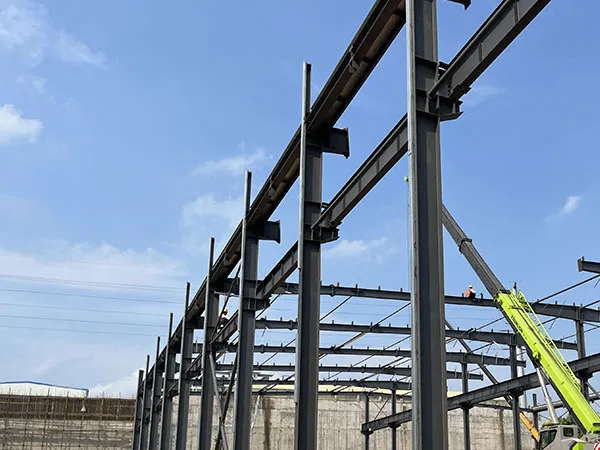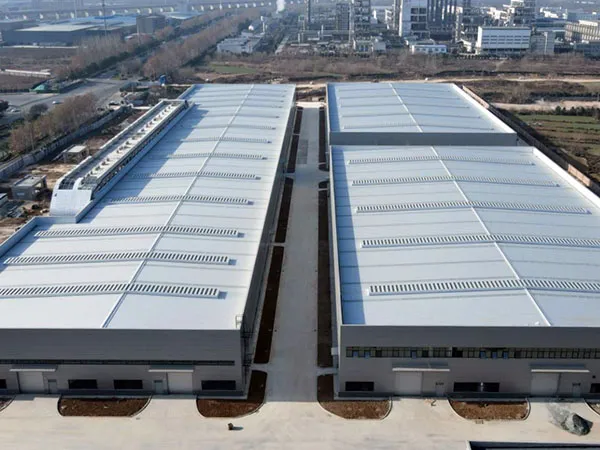Time:2025-05-21 07:01:52 Source:Sanjian Meichen Steel Structure
In today's rapidly developing industrial age, an efficient, safe, economical, and environmentally friendly industrial plant is the cornerstone of business success. Meichen Steel Structure understands your needs and specializes in providing leading customized steel structure plant services, dedicated to creating modern industrial buildings that best suit the production processes and future development plans of various industrial enterprises. Whether it's a heavy machinery manufacturing workshop, a large-scale storage center, or a high-tech production base, we provide one-stop solutions from conceptual design to detailed manufacturing and on-site installation.
Customizing a steel structure factory involves tailoring the design, layout, materials, and functionality of the building to meet your specific operational requirements. Here’s a step-by-step guide to help you effectively customize a steel structure factory.
Choosing steel structures means choosing efficiency and a future-oriented future. Compared to traditional concrete structures, steel structures offer several significant advantages:
Superior Strength and Seismic Resistance: Steel's inherent strength and toughness allow it to withstand greater loads and demonstrate enhanced resistance to damage from natural disasters like earthquakes, ensuring the safety of personnel and property.
Short Construction Time and High Cost-Efficiency: Steel components can be prefabricated in the factory, requiring only simple on-site hoisting and connection. This significantly shortens the construction cycle, saves labor and time, and allows your project to be operational sooner.
High Space Utilization: Steel structures allow for large spans and spacious layouts, providing greater flexibility for production line and equipment layouts. They eliminate the need for excessive internal support and improve space utilization.
Environmentally Friendly and Sustainable: Steel has a high recycling rate, aligning with green building principles. During the construction process, dry construction reduces environmental pollution.
Easy to Modify and Expand: As your business grows, steel structures can be easily expanded, renovated, or restructured, leaving valuable space for future growth.
We firmly believe that every custom project should begin with in-depth communication and meticulous planning. Meichen Steel Structure's customization process is designed to ensure your needs are fully understood and perfectly realized:
Requirements Communication and Preliminary Proposal: Our professional team will conduct detailed discussions with you to understand your site conditions, production processes, equipment requirements, budget, and timeline. Based on this, we will provide a preliminary design concept and feasibility analysis.
Precise Design and Detailed Development: Our experienced designers will utilize advanced BIM (Building Information Modeling) technology and specialized software to perform structural calculations and create construction drawings, ensuring the accuracy, safety, and cost-effectiveness of the design. We will also provide 3D renderings, giving you a preview of the future factory.
Component Manufacturing and Quality Control: Our modern production facility is equipped with automated production lines and high-precision processing equipment. From raw material procurement, cutting, welding, rust removal, to painting, every step strictly adheres to the ISO9001 quality management system to ensure that all steel components meet the highest standards.
Professional Installation and Site Management: Our experienced construction team will strictly follow the design drawings and construction specifications during on-site installation. We prioritize construction safety, schedule management, and environmental protection to ensure timely and high-quality project completion.
Completion Acceptance and After-Sales Service: Upon completion, we will work with you to conduct a detailed acceptance inspection. Meichen Steel Structure also provides comprehensive after-sales service to ensure the long-term and stable operation of your plant.

Extensive Project Experience: Over the years, we have successfully provided steel structure factory solutions to numerous domestic and international companies, accumulating extensive industry experience and a strong reputation.
Top-Notch Technical Team: Our team of engineers and designers possesses deep expertise and innovative capabilities, enabling them to address a wide range of complex challenges.
Advanced Production Equipment: Our in-house, modern production facility ensures product quality and efficient delivery.
Strict Quality Standards: From material selection to production and installation, we rigorously control the entire process and meet international standards.
Customized Service: We understand that each customer's needs are unique, so we provide highly customized services to ensure a solution that perfectly matches your business.
A large logistics and warehousing center: Utilizing a long-span steel structure design, this center achieves efficient cargo turnover and improves storage capacity.

A machinery manufacturing workshop: Combined with the crane beam design, it meets the needs of heavy equipment lifting and ensures production safety.

No matter your industry or the size of your project, Meichen Steel Structure is your trusted partner. Contact our professional team today for a free consultation and custom quote. Let's work together to build the industrial space of your dreams!
Contact Number: +86 13383791128
Email: info@meichensteel.com
Online Inquiry: +86 13383791128
Company Address:Bearing industrial park in Yiyang County Luoyang City, China
1. How long does it typically take to build a steel structure factory?
Depending on the scale and complexity, generally small to medium-sized projects (several thousand square meters) can be completed within 3-6 months of design + construction; large or complex projects may take 6-12 months.
2. How much more expensive is a custom-built steel structure factory than a standard one?
Due to personalized design, load resistance, node complexity, ventilation and lighting, etc., customization is usually 10%-30% higher than standard factory buildings.
3. How can costs be controlled?
Modular design, standardized components, reasonable spans, reduction of special-shaped components, minimization of on-site welding, early collaboration with suppliers, etc.
4. What special considerations should be taken for coastal/island projects?
It is necessary to consider the problems of sea breeze and salt spray corrosion, and choose more corrosion-resistant materials/coatings; the foundation must be well treated with moisture-proof treatment and waterproof design.
5. How can structural safety be ensured?
Strictly adhere to national/local structural design standards (such as China GB specifications, European/American/local standards); node design, weld/bolt inspection, non-destructive testing, and construction quality control.